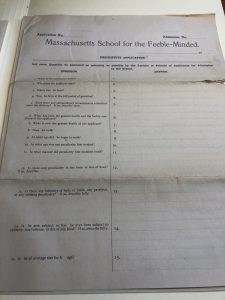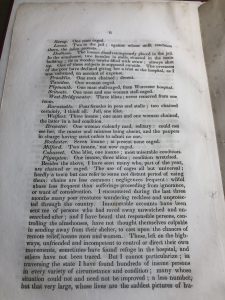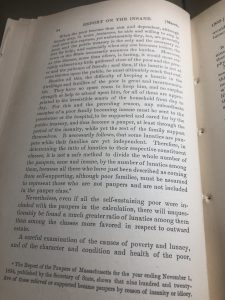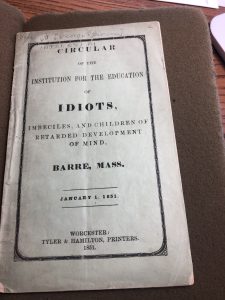By Meg Szydlik, Visitor Services Coordinator
Trigger warning: use of outdated but period-typical language to describe disabled and mentally ill individuals and includes descriptions of abuse.
In my last post, I looked at disabled people in the circus. For this post, I’m looking at how people deemed “insane,” “idiots,” or “feeble-minded” were treated. Like those of the previous post, the voices of these people were also missing in my searches of the MHS archives. What we do have, however, are records that help paint a picture of what life was like for someone “insane” and how abled people perceived them.
Insanity and feeble-mindedness cover a wide range of behaviors. In addition to mental illness and probable psychosis, developmental disorders, and neurodivergence are also included under this label. While the sources had different treatment plans, all of them used a “one size fits all” approach to these disabilities. However, modern practice is that individual treatments that center the person’s dignity are best.

In the pre-Civil War era when the materials I used were written, there were essentially two options for people considered insane. They could stay at home with family, or they could enter an institution. Poorhouses, hospitals, and even jails were used to house those the state deemed insane.
Whatever the caretakers of these places thought they were doing, Dorothea Dix’s Memorial: To the Legislature of Massachusetts demonstrated their actions were abusive. Originally delivered orally, her testimony was published and made its way into the MHS collection. It features page after page of stories of people being beaten, chained, and deprived of food, bathrooms, and clothing and even light or shelter. The abuse is horrifying to read and must have been even worse to hear about. However, I’m glad Dix was clear and explicit about the harm, as she says herself, “the condition of human beings reduced to the extremest states of degradation and misery, cannot be exhibited in softened language, or adorn a polished page.” You can read her words yourself by visiting the MHS or by reading an online copy.

In addition to Dix’s more personal words, the MHS has government documents on the topic, including a copy of the Report on insanity and idiocy in Massachusetts by the Commission on Lunacy under resolve of the Legislature of 1854. This report looks at how insane persons were counted and treated in Massachusetts, starting with the complications involved in getting an accurate count of these populations because of the shame associated with the diagnosis. Their review revealed interesting things, including a fairly even gender split, a belief that lunacy is curable, and disproportionate numbers of “aliens,” or non-Americans, receiving treatment in institutions. The treatment of non-Americans was especially interesting, with the writers pre-answering critiques by countering that these “generous provisions for the alien lunatics will not be questioned here, for not one of these thus provided for should have been neglected. Indeed, it is the great honor of our Commonwealth that it has built…these institutions for the relief of the suffering.” Though lacking in many areas, this report and the men who created it seemed to have the dignity of the people they were serving at the core, which was comforting. Despite these positive elements, these documents are still primarily about abled people’s responses and responsibilities. The voices of the “insane and idiots” are not present in the text.

The final materials I examined were ephemera and reports from The Massachusetts School for the Feeble-Minded. Archivist Susan Martin wrote a wonderful blog post about the collection, so I won’t rehash everything, but I did find it interesting how these materials fit with the other documents the MHS has about idiocy and insanity. The reports are focused on how well students are progressing, as well as the work and value of the school. It operated significantly more like modern schools for severely disabled people than anything else I looked at, which is striking given that the documents are still pre-Civil War. Still, there is no element of the student voice anywhere in the ephemera, which consists largely of information on how to enroll and what to bring rather than content produced by students. Once again, abled people are telling disabled people’s stories–no matter how well-meaning they are.

Reading about the treatment of what was deemed idiocy and insanity was a deeply upsetting experience that required breaks. There’s so much dehumanization in the sources and even Dorothea Dix’s testimony, the source that focused primarily on their humanity and victimhood, highlighted that dehumanization. The treatment of these disabled people is, quite frankly, horrifying. In many ways, I see echoes of that treatment in the present with things like #FreeBritney and Disabled Day of Mourning.
Tune in next time, when I will look at some of the ways disabled veterans are represented in the archive.

